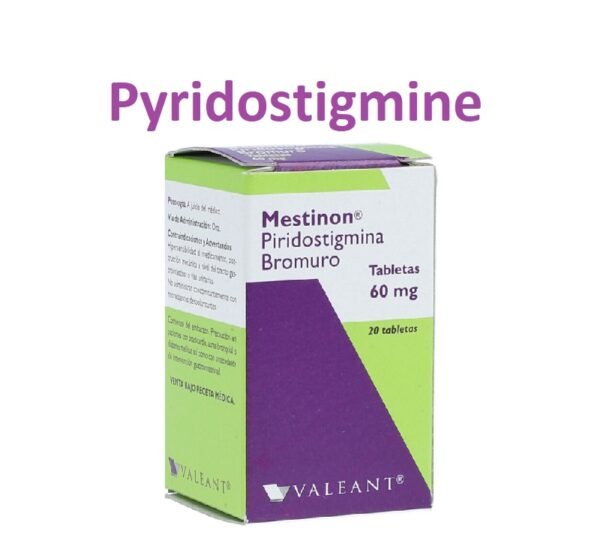Pyridostigmine (Mestinon, Amygra) is a reversible cholinesterase inhibitor that inhibits the breakdown of acetylcholine. It improves muscle strength in patients with myasthenia gravis and is used to reverse the effects of non-depolarizing muscle relaxants.
Pyridostigmine Uses:
- Myasthenia gravis:
- Oral treatment is indicated for the treatment of myasthenia gravis.
- Reversal of nondepolarizing muscle relaxants:
- The injectable formulation is indicated for the reversal of nondepolarizing muscle relaxants.
- Military use:
- It is also used as pretreatment for Soman nerve gas exposure
- Off-Label Use of Pyridostigmine in Adults:
- It is indicated for the alleviation or prevention of anticholinergic adverse effects induced by Disopyramide
- Parenteral (IM, IV) formulation may also be used in Myasthenia gravis.
Pyridostigmine dose in Adults
Pyridostigmine Dose in the treatment of Myasthenia gravis:
- Oral: Highly individualized dosing ranges:
- Immediate-release:
- 60 - 1,500 mg per day, usually 600 mg per day given in 5 to 6 divided doses
- Sustained-release:
- 180 - 540 mg once or twice a day (at least duration of 6 hours between doses); Note: Use of immediate-release therapy may be necessary for combination with sustained-release therapy.
- Immediate-release:
- IM, IV (off-label use):
- To supplement during labor and postpartum.
- In a Myasthenic crisis when oral therapy can not be given: ~1/30th of oral dose should be given;
- Strict monitoring of the patient for cholinergic reactions. The intravenous route may cause significant complications e.g. cardiac arrest.
- The intramuscular route is preferred. In a myasthenia crisis, continuous infusion may also be given.
- Continuous IV infusion:
- 1 - 2 mg per hour, gradually titrate with increments of 0.5 to 1 mg per hour,
- The maximum rate: 4 mg per hour
Pyridostigmine Dose in the treatment of Reversal of nondepolarizing muscle relaxants:
- IV: 0.1 - 0.25 mg/kg/dose (onset to peak effect is dose-dependent; return of twitch height to 90% of control occurs within ~6 minutes; full recovery usually occurs within 15 to 30 minutes)
Note:
- Muscle twitch response to peripheral nerve stimulation should be monitored;
- Pyridostigmine to be administered after spontaneous recovery of neuromuscular function has begun.
- To minimize the side effects, Atropine sulfate or glycopyrrolate should be given before or simultaneously with pyridostigmine.
- There is a possibility of inadequate reversal; additional doses are not recommended. till adequate recovery, it should be managed by manual or mechanical ventilation.
Pyridostigmine dose in the pre-treatment of Soman nerve gas exposure (military use):
Note: It is used as premedication, pyridostigmine after Soman exposure should not be given; It is not effective and may be harmful if taken immediately before exposure or at the same time, as it can exacerbate the effects of sub-lethal exposure to Soman.
- Oral: 30 mg every 8 hours, should start taking several hours before exposure; at the first sign of Soman exposure discontinue it, then immediately start atropine and pralidoxime.
Pyridostigmine dose in the treatment of disopyramide-induced anticholinergic adverse effects (off-label):
- Oral: Sustained-release: 90 - 180 mg every 12 hours or as needed
Pyridostigmine dose in Childrens
Note: Every paediatric dosage guideline is based on the product formulations for immediate release.
Pyridostigmine dose in the treatment of congenital myasthenic syndromes:
- Infants, Children, and Adolescents:
- Oral: 1 mg/kg/dose every four hours; typical range: 4–5 mg/kg/day in divided doses of four to six; maximum daily dose: 7 mg/kg/day in split doses of five to six
Pyridostigmine dose in the treatment of Juvenile Autoimmune myasthenia gravis:
- Infants, Children, and Adolescents:
Note: Larger doses should be administered prior to the time of greatest fatigue.
-
- Oral:
- 1 mg/kg/dose every 4 - 6 hours;
- The maximum daily dose: 7 mg/kg/day in 5-6 divided doses;
- The usual daily dose: 600 mg/day; doses as high as 1500 mg/day have been used
- IM, IV:
- 0.05-0.15 mg/kg/dose;
- The maximum dose: 10 mg
- Oral:
Pyridostigmine Dose in the treatment of Reversal of nondepolarizing neuromuscular blocker:
- Infants, Children, and Adolescents:
- IM, IV: 0.1- 0.25 mg/kg/dose.
- Note: To reduce side effects, atropine or glycopyrrolate should be administered right away.
Pyridostigmine Dose in the treatment of Vincristine-induced neurotoxicity:
- Children ≥2 years and Adolescents:
- Oral: 3 mg/kg/day in 2 divided doses, with pyridoxine for 3 weeks.
Pregnancy Risk Factor B/C (manufacturer dependent)
- Studies on animal reproduction have not shown any adverse effects.
- It can also cross the placenta, which can cause transient neonatal myasthenia graveis in 10-15% of neonates.
- This is because maternal antibodies can cross over the placenta.
- Myasthenia gravis can be treated with pyridostigmine during pregnancy. It should also be used during labor.
- The mother's health and prognosis should be considered.
- If there is clear indication that the mother needs antidotes, it should be administered without fear of teratogenicity.
Use of pyridostigmine during breastfeeding
- Breastfeeding women should be aware that Pyridostigmine can be found in breast milk.
- Breastfeeding can lead to myasthenia gravis exacerbations if the mother is not well controlled.
- Myasthenia gravis infants may experience transient myasthenia graveis as a newborn.
- They may also have difficulty eating and should be closely monitored for fatigue.
- According to current guidelines, breastfeeding is safe for women who are taking pyridostigmine for myasthenia Gravis.
- Two mothers who used pyridostigmine to treat myasthenia gravis during pregnancy and after giving birth are available.
- They were given 180 mg to 300 mg/day and samples were taken from 5 - 102 days after delivery.
- The plasma concentrations of infants were much lower than the limit of quantification.
- Also, the average milk concentration quantified was =0.1% of weight-adjusted maternal dose.
Dose in Kidney disease:
No dosage adjustments on labeling. However.
There is prolong elimination in renal impairment, lower initial dose may be required.
Dose in Liver disease:
No dosage adjustments listed in the manufacturer's labelling.
Side Effects of Pyridostigmine:
- Central Nervous System:
- Twitching
- Hyperesthesia
- Dermatologic:
- Xeroderma
- Gastrointestinal:
- Abdominal Pain
- Diarrhea
- Genitourinary:
- Dysmenorrhea
- Urinary Frequency
- Neuromuscular & Skeletal:
- Myalgia
- Neck Pain
- Ophthalmic:
- Amblyopia
- Respiratory:
- Epistaxis
Uncommon Side effects of Pyridostigmine:
- Cardiovascular:
- Bradycardia (Transient)
- Chest Tightness
- Decreased Heart Rate
- Increased Blood Pressure
- Central Nervous System:
- Confusion
- Depressed Mood
- Disturbed Sleep
- Drowsiness
- Headache
- Hypertonia
- Lack Of Concentration
- Lethargy
- Localized Warm Feeling
- Numbness Of Tongue
- Tingling Of Extremities
- Vertigo
- Dermatologic:
- Alopecia
- Diaphoresis
- Skin Rash
- Gastrointestinal:
- Abdominal Cramps
- Bloating
- Borborygmi
- Flatulence
- Increased Peristalsis
- Nausea
- Salivation
- Vomiting
- Hypersensitivity:
- Hypersensitivity Reaction
- Neuromuscular & Skeletal:
- Fasciculations
- Muscle Cramps
- Weakness
- Ophthalmic:
- Eye Pain
- Lacrimation
- Miosis
- Visual Disturbance
- Respiratory:
- Acute Bronchitis (Exacerbation)
- Exacerbation Of Asthma
- Increased Bronchial Secretions
Contraindications to Pyridostigmine:
- Hypersensitivity to any anticholinesterase agent or component of pyridostigmine
- Occlusions of the urinary tract or stomach by mechanical means
- It is not known if anticholinergic stimulants cause allergic reactions.
- Cross-sensitivity is possible because of the similar chemical structure and pharmacological effects.
Warnings and precautions
- Cholinergic effects
- You may experience excessive cholinergic activity symptoms, such as: There may be excessive cholinergic activity symptoms such as salivation, sweating and urinary incontinence.
- Overdose can cause a cholinergic crises (e.g. In the event of an overdose, such as muscle weakness, discontinue use immediately. Cholinergic crisis should be distinguished from myasthenic crises.
- Hypersensitivity reactions
- Hypersensitivity reactions are possible. Keep atropine or epinephrine on hand to treat such reactions.
- Cardiovascular disease
- The dangers of having a Bradycardia or any other cardiac arrhythmias are real. Use caution when treating cardiac patients with Bradycardia or other cardiac arrhythmias
- Glaucoma
- It may be combined with antiglaucoma medications to cause or exacerbate night-vision problems.
- Renal impairment
- Patients with impaired renal function should be cautious. A lower initial dose should be used first, then increase the dosage.
- Respiratory disease
- Patients with chronic pulmonary diseases such as asthma, bronchospastic or chronic obstructive lung disease (COPD) should be cautious.
Pyridostigmine: Drug Interaction
Note: Drug Interaction Categories:
- Risk Factor C: Monitor When Using Combination
- Risk Factor D: Consider Treatment Modification
- Risk Factor X: Avoid Concomitant Use
Risk Factor C (Monitor therapy) |
|
|
Amifampridine |
Acetylcholinesterase Inhibitors may enhance the therapeutic effect of Amifampridine. Amifampridine side effects may also be increased. Amifampridine may enhance the therapeutic effect of Acetylcholinesterase Inhibitors. Acetylcholinesterase inhibitor side effects may also be increased. |
|
Anticholinergic Agents |
The therapeutic benefit of anticholinergic agents may be reduced by acetylcholinesterase inhibitors. Acetylcholinesterase Inhibitors' therapeutic impact may be reduced by anticholinergic drugs. |
|
Benoxinate |
Benoxinate's therapeutic impact may be enhanced by acetylcholinesterase inhibitors. Benoxinate's effects, in particular, could last longer. |
|
Beta-Blockers |
BetaBlockers' bradycardic action may be enhanced by acetylcholinesterase inhibitors. Levobunolol and metipranolol are exceptions. |
|
Cholinergic Agonists |
Cholinergic agonists may have a more negative or toxic effect when used with acetylcholinesterase inhibitors. |
|
Corticosteroids (Systemic) |
The hazardous or harmful effects of acetylcholinesterase inhibitors may be increased. Muscle weakness could become more pronounced. |
|
Acrylcholinesterase Inhibitors' therapeutic impact can be lessened. |
|
|
May lessen Pyridostigmine's therapeutic effects. |
|
|
Neuromuscular-Blocking Agents (Nondepolarizing) |
The neuromuscular-blocking impact of neuromuscular-blocking agents may be lessened by acetylcholinesterase inhibitors (Nondepolarizing). |
Risk Factor D (Consider therapy modification) |
|
|
Acetylcholinesterase Inhibitors may increase the serum concentration of Succinylcholine. Management: Because of the possibility of long-lasting neuromuscular inhibition, consider alternatives to this combination. |
|
Monitoring parameters:
- ECG
- Blood pressure and heart rate especially with IV
- Cholinergic reactions (eg, nausea, vomiting, diarrhea, increased salivation), especially with IV use
How to administer Pyridostigmine (Mestinon, Amygra)?
Oral:
- Swallow whole, do not crush the extended-release tablet.
IV:
- For reversal of nondepolarising Muscle relaxants.
- Myasthenic crisis (off-label use) administer Intramuscular, slow intravenously, or as a continuous infusion.
- Patients who may need larger doses should be treated with atropine before pyridostigmine treatment.
Mechanism of action of Pyridostigmine (Mestinon, Amygra):
- Acetylcholinesterase, an enzyme that is responsible for the metabolism acetylcholine and facilitates impulse transmission across the neuromuscular junction, is also known as Acetylcholinesterase.
- Pyridostigmine prevents the destruction by acetylcholinesterase of acetylcholine and facilitates impulses across neuromuscular junction
The onset of action:
- Recovery from vincristine neurotoxicity: Onset of action: 1 to 2 weeks
- Myasthenia gravis:
- Oral: Within 30 minutes
- IM: 15 - 30 minutes
- IV: 2 - 5 minutes
Duration:
- Oral: 3 - 4 hours in the daytime
- IM, IV: 2 - 3 hours
Absorption: Oral:
- Very poor
Protein Binding:
- None
Metabolism:
- Cholinesterase enzymes break it down in the liver and tissue locations.
Bioavailability:
- 10% to 20%
Half-life elimination:
- Oral: 1 - 2 hours; renal failure: ~6 hours
- IV: ~1.5 hours
Time to peak plasma concentration after oral administration:
- 1 - 2 hours
Excretion:
- Through Urine (80% to 90% as unchanged drug)
International Brand Names of Pyridostigmine:
- Mestinon
- Regonol
- Mestinon SR
- Amygra
- Antilon
- Astinon
- Brostagin
- Delostigar
- Distinon
- Dosmin
- Dostimid
- Kalymin
- Meshanon
- Mestinon
- Mestinon Retard
- Mestinon Timespan
- Pyrido
- Pyrimine
- Pyrinol
- Pyrinon
- Pystinon
- Stigmide
Pyridostigmine Brand Names in Pakistan:
Pyridostigmine Bromide Tablets 60 mg in Pakistan |
|
|
Amygra |
Tabros Pharma |




